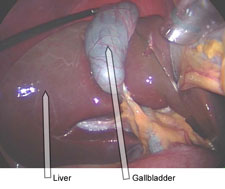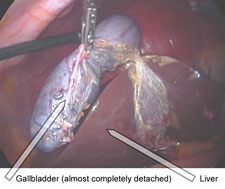Vein Clinic:
‑ Ultrasound Evaluation‑ Sclerotherapy
‑ Mini‑Phlebectomy
‑ Endovenous Laser Therapy

Our Vein Clinic is a state-of-the-art facility providing the latest technological advances in vein treatment, specializing in Endovenous Laser Therapy.
More info...
Gallbladder
Bile assists in the digestion of fats. It is produced by the liver and stored in the gallbladder. Following a fatty meal, the gallbladder contracts and delivers bile into the intestine to assist with digestion. In the case of gallbladder malfunction, bile within the gallbladder becomes stagnate and can form stones. These stones, called gallstones, cause symptoms when they lodge in the duct or tube that empties the gallbladder.The most frequent symptom is pain in the upper abdomen, either in the center of the abdomen just below the breastbone, or beneath the right ribs. The pain usually lasts minutes to a few hours, and most often occurs following meals, especially fatty meals. Many people experience nausea. Sometimes the pain can awaken the patient in the early morning hours. In some patients the pain appears to penetrate through to the right back. If the stone that blocks the outlet of the gallbladder lodges, infection can occur in the gallbladder causing cholecystitis. This may require emergency medical treatment.
Recommended treatment:
For the sympthomatic cholelithiasis (gallbladder stones) or cholecystitis we usually recommend laparoscopic cholecystectomy.
 Laparoscopic cholecystectomy is an operation to remove the gallbladder using small incisions. The operation is performed with three or four tiny punctures holes. The surgeon inserts an instrument called a laparoscope through one of the punctured holes which provides a view of the inside the abdomen. Long thin instruments are passed through the other holes to carry out the operation. The gallbladder is detached from the liver and clips are applied to the artery that supplies the gallbladder and to the gallbladder “duct”, a small tube that drains the gallbladder into the bile duct. The gallbladder is then collapsed and drawn out through one of the punctures holes like an empty balloon.
Laparoscopic cholecystectomy is an operation to remove the gallbladder using small incisions. The operation is performed with three or four tiny punctures holes. The surgeon inserts an instrument called a laparoscope through one of the punctured holes which provides a view of the inside the abdomen. Long thin instruments are passed through the other holes to carry out the operation. The gallbladder is detached from the liver and clips are applied to the artery that supplies the gallbladder and to the gallbladder “duct”, a small tube that drains the gallbladder into the bile duct. The gallbladder is then collapsed and drawn out through one of the punctures holes like an empty balloon.  Most operations last twenty five to forty-five minutes. Most patients leave the hospital on the same day and gradually resume their normal activities over the next five to seven days. Only a few doses of over the counter pain medicine are needed after surgery.
Most operations last twenty five to forty-five minutes. Most patients leave the hospital on the same day and gradually resume their normal activities over the next five to seven days. Only a few doses of over the counter pain medicine are needed after surgery. The traditional “open” (non-laparoscopic) gallbladder surgery requires a much larger incision, causing discomfort for several days and disability for several weeks.
The major risk of gallbladder surgery is injury to the bile duct. This injury occurs about one to two times per thousand patients. Bile duct injury would require a major open procedure to repair the duct. As well, there are also the "usual" risks associated with general anesthesia.
You should contact your surgeon or a family doctor if you notice:
- Persistent fever over 39°C, increasing abdominal swelling, pain that is not relieved by your medications, persistent nausea or vomiting, chills, persistent cough or shortness of breath, purulent drainage (pus) from any incision, redness surrounding any of your incisions that is worsening or getting bigger, you are unable to eat or drink liquids.
Back to Minimally Invasive Surgery main page.
Contact Us
Minimally Invasive Surgery:
‑ Appendix‑ Bowel
‑ Gallbladder
‑ Gastro‑esophageal Reflux
‑ Hernias
‑ Rectum & Anus
‑ Spleen
‑ Varicose Veins
Endoscopy:
‑ Gastroscopy‑ Colonoscopy
Other:
‑ Breast‑ Thyroid